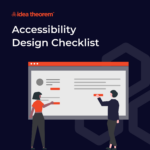If you’re designing a SaaS product, a website, or even an app and you’re working with UX designers, you may have heard the term “information architecture” (IA) quite a bit – and you may not be sure what it means, or how it relates to UX design.
In this guide, we’ll be taking an in-depth look at information architecture, and how it relates to UX design. You’ll learn everything you need to know in order to understand the concept of information architecture in detail. Let’s get started.
Defining Information Architecture – What Is It?
When it comes to incorporating any kind of information, the human brain needs one thing – structure. Imagine trying to read a dictionary that wasn’t in alphabetical order, a novel that does not have its chapters arranged in the correct sequence, or a textbook without a table of contents, glossary, or bibliography.
In the same way, we need a consistent structure that we can use when we’re browsing information online. That’s information architecture – the art and science of designing navigational systems and constructing content in such a way that it’s intuitive to browse and understand on websites, web and mobile apps, software, and more.
To boil it down further, information architecture is the practice of figuring out how you can arrange the parts of something to make it understandable. The goal is to organize content in such a way that users can quickly adjust to how the product works, and find everything that they need without making a big effort.
The structure of the content and the method by which this is achieved is different, depending on the application or website. A SaaS product, for example, has different needs than an eCommerce site, because the purpose of each is distinct.
Understanding The Role Of Information Architecture In Design
In any effective development project, information architecture helps define the “skeleton” of a project. UX Designers typically focus on IA first, before determining a design approach and developing further any design elements.
This is because design elements – from visual elements and graphics to interactions, functionality, and navigation – must be built on strong information architecture. Even the best content and design will fail without using appropriate IA. UX is important, but even if an app or a website looks great, users will quickly become frustrated if it becomes clear that the information is not organized properly, and it’s confusing to use.
IA And UX Design – How Do They Relate?
If you know a bit about UX design, you may be wondering if there is really a difference between IA and UX at all. After all, they’re both concerned with intuitive user experience, simple navigation, and other such things, right?
It’s true that these two terms do relate to one another, but they are not the same. You can think of IA as a blueprint for a home – while UX design is more like the finished house.
In other words, IA is a basic design structure of information – one that can be turned into wireframes and sitemaps. It’s a high-level hierarchy that is used to organize, catalog, and understand the placement of content in any product. When building a new website, SaaS product, or app, UX designers use IA as a way to construct an outline of how the site will work, so that they can plan out a navigation system.
UX, on the other hand, is concerned with much more than simply structuring content. Using IA principles in UX is important, of course. But there are many other things that UX designers must focus on, too – like influencing user behavior, making it pleasant to interact with the product, designing intuitive navigational systems, and much more.
So, you can think of IA as the foundation or blueprint of UX. Both IA and UX are essential for a great product because, without strong IA, your content will be difficult to navigate – but without proper UX, it will not be fun to navigate. Both practices build upon one another, and both are used by most UX designers who specialize in user-focused design.
Understanding IA System Components And What They Are
If you’d like to dive more deeply and understand a bit more about IA, it’s a good idea to have basic knowledge about each individual component of information architecture.
The information architecture components – organization systems, labeling systems, navigation systems, and searching systems – are defined in Information Architecture for the World Wide Web, one of the pioneering texts in this field. Below are more in-depth meanings of each component.
Organization Systems
Organization systems are, as the name implies, a way to categorize how information is divided. They are designed to help users predict where they will be able to find a certain type of information. There are three main types of organizational systems.
- Hierarchical – Using a visual hierarchy helps users determine the importance of each individual element. By using things like contrasting fonts, element sizes, and colors, users can quickly understand the important information on a page at a glance.
- Sequential – This type of organization system creates a path for a user. Imagine checking out on Amazon or another online retailer. You know what to expect – click your shopping cart, view your order summary, check out, choose your shipping address, enter your payment method, and then confirm your order and place it. That’s an example of a sequential organization system.
- Matrix – Matrix organization systems allow users to browse content based on different kinds of groupings or “schemes.” By doing things like allowing users to sort information by alphabetical order, date, topic, and other categories, users can quickly find what they’re looking for.
Almost every website, SaaS product, and app uses a combination of all of these information architecture systems to provide a seamless, intuitive user experience.
Labelling Systems
Labeling systems are a way to simplify data representation and group multiple sets of data and content into just a few words, allowing for easier navigation.
If your website has a “Contact” page, for example, this is an example of a labeling system. Ditch scattered info! Group contact details on a clear “Contact Us” page. Your user understands that they’ll find that information on the “Contact” page.
Navigation Systems
Navigation guides users through apps and websites, helping them find what they need and get things done.
There are many different types, including embedded navigation, global navigation, local navigation, contextual navigation, supplemental navigation, and more.
Searching Systems
Searching systems allow users to enter search terms into a search bar – just like they would in a search engine like Google – and find the results that they are looking for quickly. This is a great choice for websites and apps with a huge amount of data and different features.
Imagine trying to use an enormous website like Amazon.com without a search bar, and you’ll understand why searching systems are so important in some websites and applications.
Final Thoughts
IA & UX: Different, but best friends! IA maps the user journey, UX designs the experience. This not only helps the designers but also helps stakeholders and devs understand how the product will flow.
Want to learn more? Check out the Idea Theorem™ blog for more information about these topics and much more.
—
What’s Next
Idea Theorem is an award-winning design & development agency based in North America. Through our empathy-driven approach, we have crafted digital products that have positively impacted over 10 million users. Our mission is to shape the digital future by delivering exceptional experiences. Contact Us if you have any questions; we will gladly help you.






